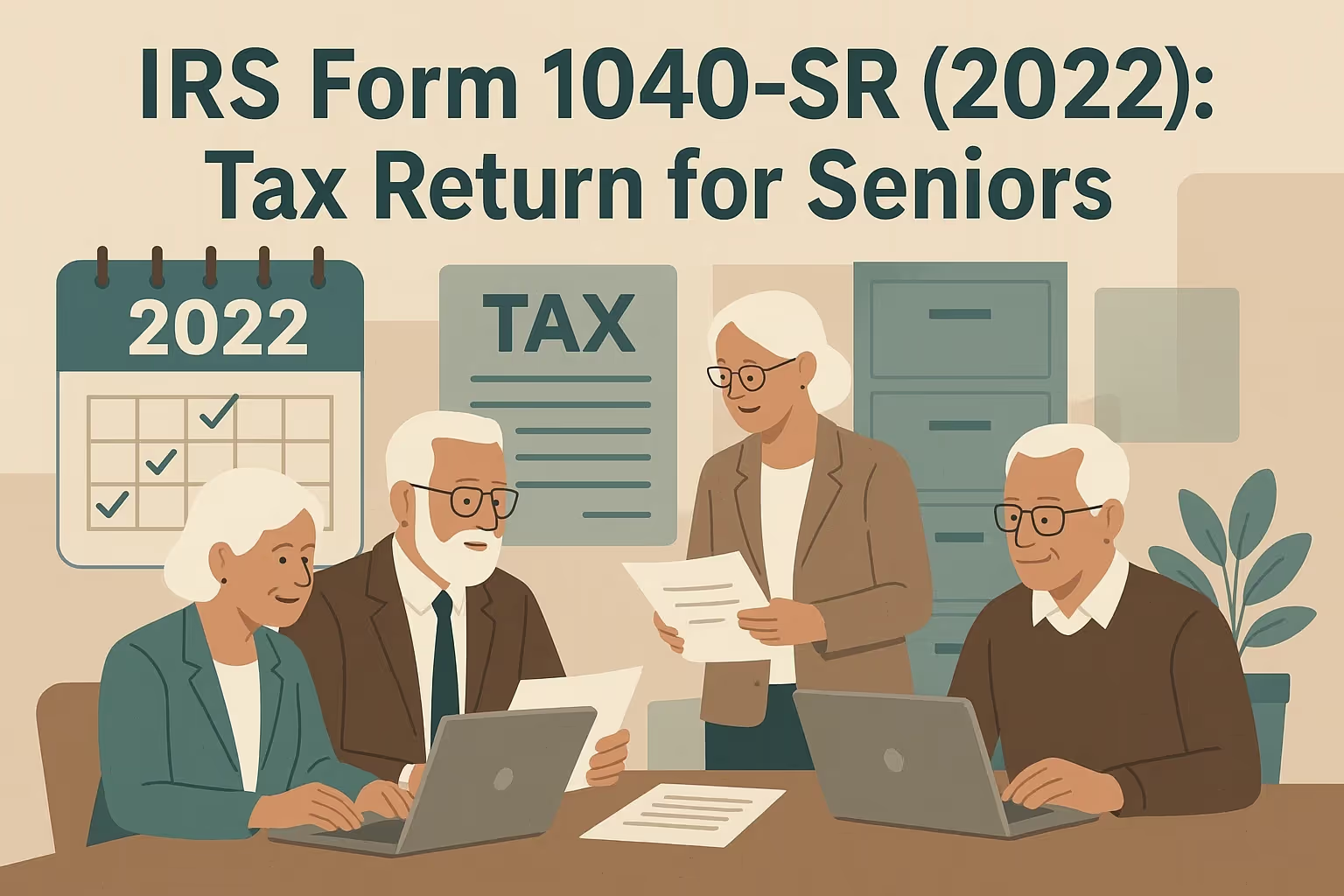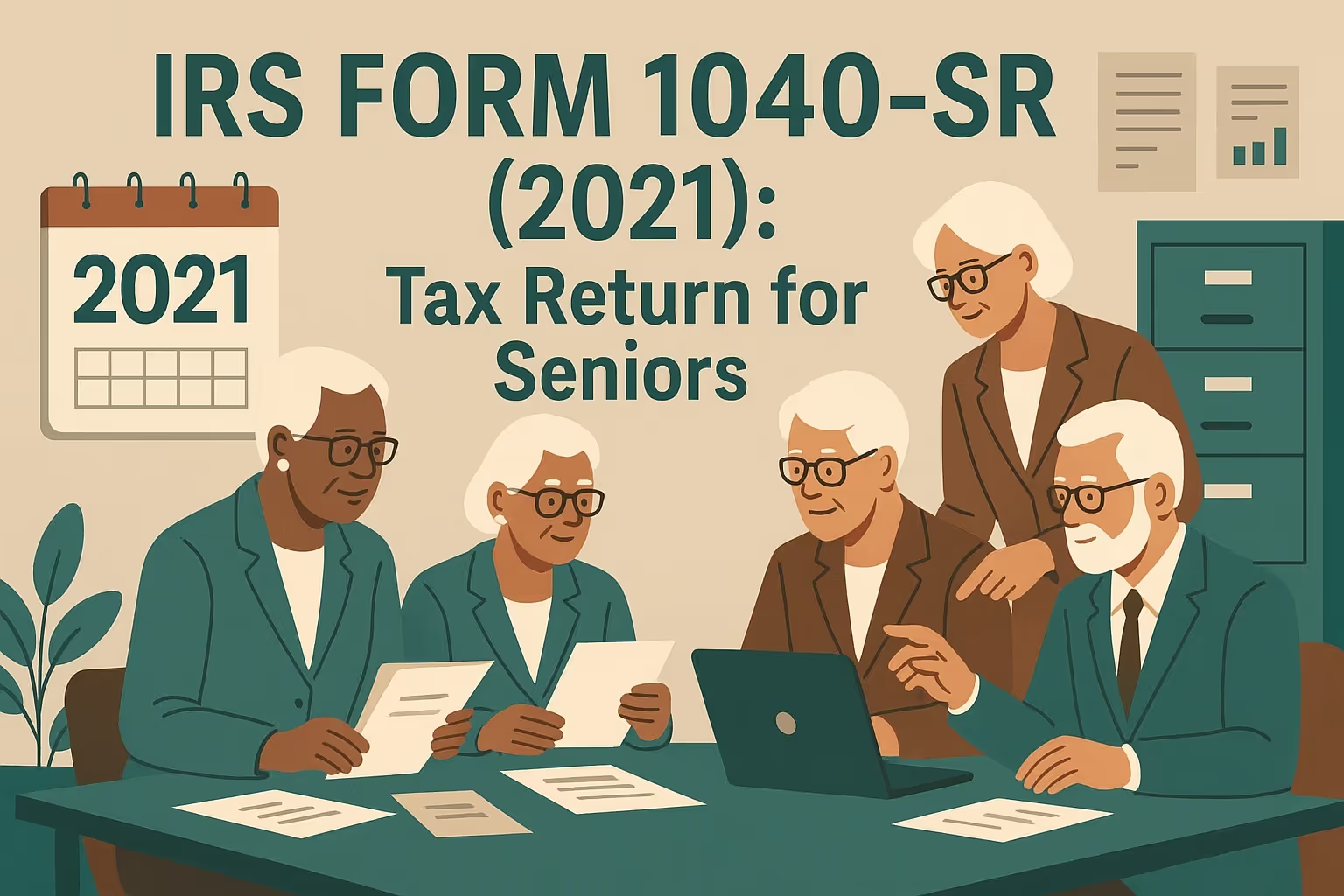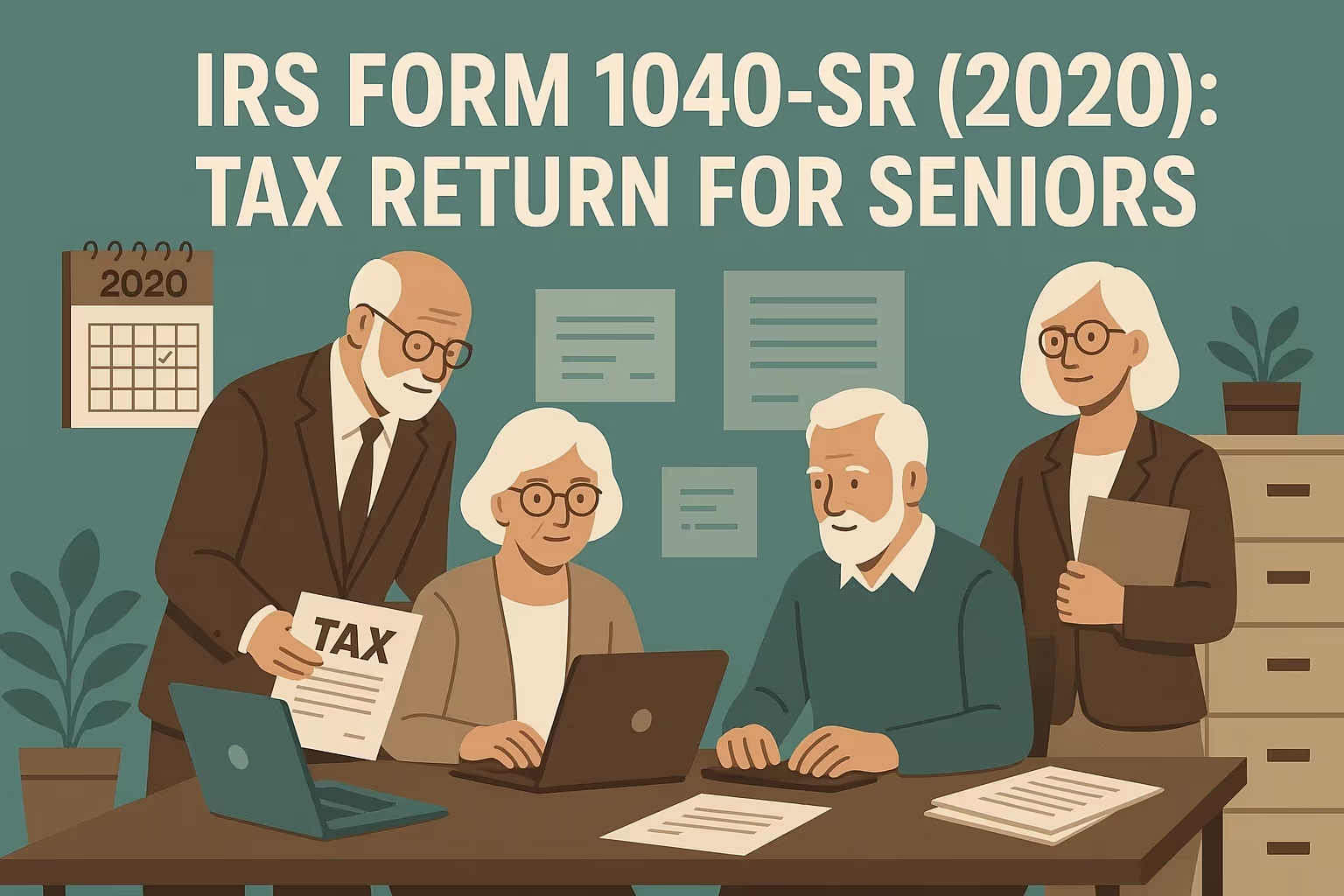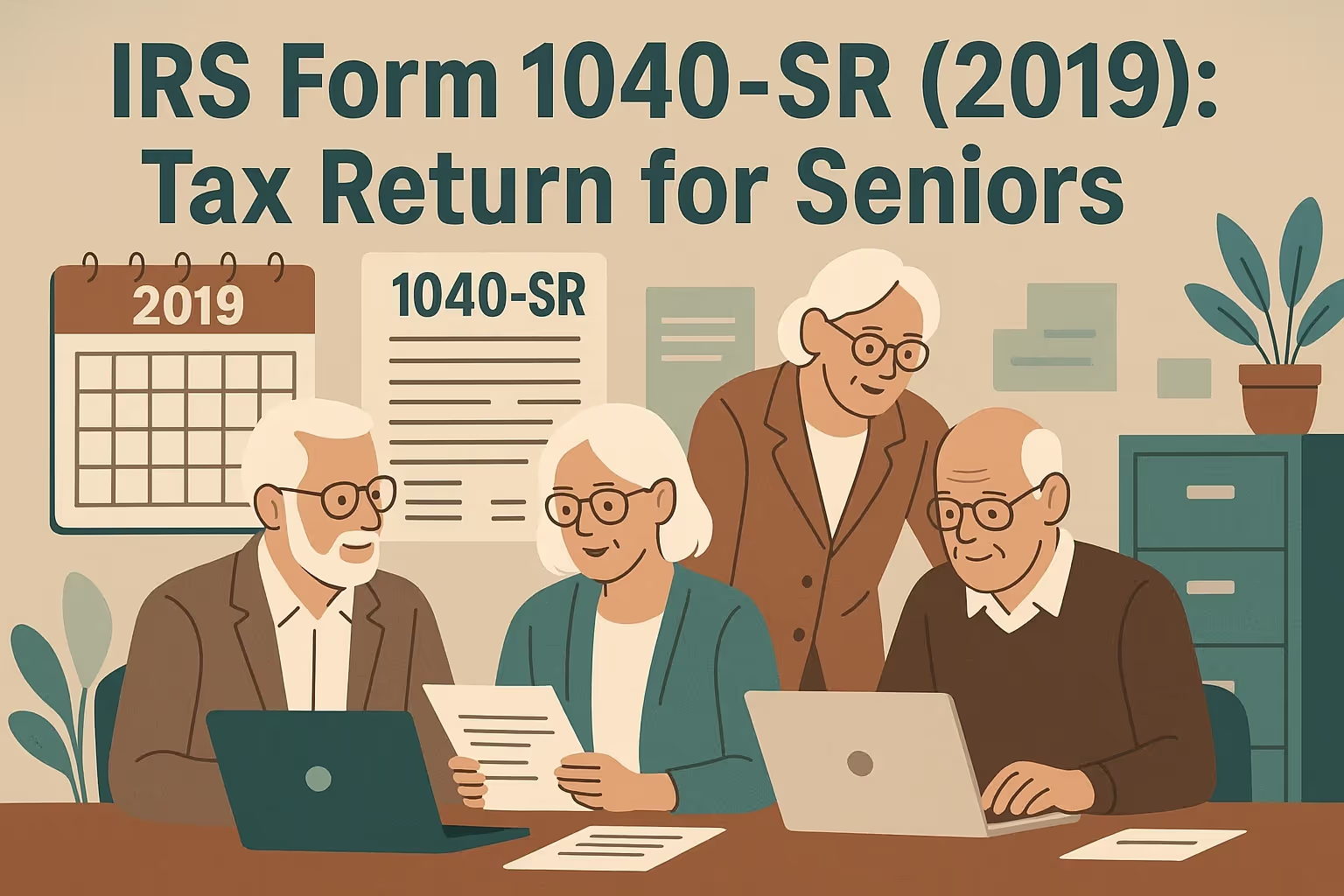Form 1040SR 2020 Instructions: Filing Guide for Seniors
Filing a federal income tax return can feel complicated, but older adults have a form created just for them. The Internal Revenue Service (IRS) introduced Form 1040-SR, also known as the “U.S. Tax Return for Seniors,” to simplify the process for taxpayers age 65 and older. It features larger print, an easy-to-read layout, and a built-in standard deduction chart to make filing more accessible.
This guide systematically explains how to file Federal Form 1040-SR for 2020. It’s designed for newly retired seniors catching up on prior years or preparing to file independently. You’ll learn how to report wages, pensions, and Social Security benefits, claim the Recovery Rebate Credit, and submit your return by mail or electronically through e-file.
Every section follows official IRS instructions to help ensure accuracy and confidence when filing. The guide also identifies common errors, highlights key 2020 updates, and lists free assistance programs for seniors. Whether you plan to prepare your tax return or use an IRS-certified service, understanding Form 1040-SR makes the process easier. You’ll know how to correctly review and file your return, claim eligible deductions, and avoid unnecessary delays.
Understanding IRS Form 1040-SR
Filing a tax return with the correct form is the first step to complying with IRS rules. Form 1040-SR, officially titled “U.S. Tax Return for Seniors,” was created for individuals 65 and older. It offers a cleaner, more readable format while keeping the same benefits and requirements as the standard Form 1040. The design focuses on accessibility, helping older adults complete their returns accurately and confidently.
What Is Form 1040-SR?
Form 1040-SR is designed to make it easier for older people to file taxes. The IRS is doing this to help people with small print or complicated instructions file their taxes.
Key features include:
- Larger print and clearer text: The form uses a 12-point font for better visibility, reducing eye strain.
- Simplified layout: Lots of space and short instructions help filers get through each step of reporting their income, deductions, and credits.
- Built-in standard deduction chart: The deduction amounts for each filing status and age group appear directly on the form for quick reference.
- Same tax rules and schedules: Seniors using Form 1040-SR follow the same calculations and attach the schedules required for Form 1040.
Who Can Use Form 1040-SR
Form 1040-SR is available to anyone born before January 2, 1956, meaning the filer was at least 65 years old by the end of the 2020 tax year. You can use it whether you are single, married filing jointly, head of household, or a qualifying widow or widower.
Form 1040-SR may be the right choice for filers who meet the following conditions:
- Age requirement: The taxpayer was 65 or older on December 31, 2020.
- Additional documentation: The return includes schedules or extra forms to report income, deductions, or credits.
- Accessibility preference: A more straightforward layout and larger print make the form easier to read and complete.
Both forms use the exact IRS instructions and do the same tax calculations, ensuring the reports are correct and consistent.
Key Benefits for Seniors
Form 1040-SR combines ease of use with full access to federal tax benefits.
- Improved readability: Larger font and clear formatting help minimize filing errors.
- Full eligibility for deductions and credits: All standard tax benefits remain available.
- Tailored for older adults: The form accounts for age-related needs while ensuring compliance with federal requirements.
You can download the form and official Form 1040-SR 2020 instructions on the IRS Forms and Publications page (IRS.gov).
What’s New for the 2020 Tax Year
Every year, changes affect how tax returns are prepared and filed. For 2020, older adults filling out Form 1040-SR had to make a few temporary changes to help them during the pandemic and support people with fixed or limited income. The most important changes are new credits, deductions, and changes to the income limits.
Recovery Rebate Credit (Stimulus Payment)
The Recovery Rebate Credit—the 2020 Economic Impact Payment—was introduced to support taxpayers who did not receive the full stimulus amount during the 2020 tax year. Seniors eligible for this credit could claim it directly on Line 30 of Form 1040-SR.
- Eligible Credit Amount: $1,200
- Explanation: Applies to single taxpayers or those filing separately who did not receive the full stimulus payment
- Eligible Credit Amount: $2,400
- Explanation: Applies to couples filing jointly; the credit is doubled to account for both spouses
- Eligible Credit Amount: $500 per child
- Explanation: Additional credit available for each qualifying dependent younger than 17 years old
The credit reduces the total tax owed or increases any refund due. Taxpayers who received a partial payment could claim the remaining amount on their 2020 tax return. More information is available on the IRS Recovery Rebate Credit page (IRS.gov).
Unemployment Compensation Exclusion
If the filer had a modified adjusted gross income of less than $150,000 in 2020, they could have left out up to $10,200 in unemployment benefits from their taxable income. Married couples filing jointly could each exclude up to $10,200—this exclusion aimed to reduce the burden on individuals who received unemployment benefits during the year.
Charitable Contribution Deduction
Taxpayers who did not itemize deductions could still claim a limited charitable deduction for 2020. The new rule allowed up to $300 in cash donations for single filers and $600 for married couples filing jointly. Contributions had to be made in cash to qualifying charitable organizations.
Standard Deduction and Extended Deadline
The standard deduction increased slightly in 2020, with an additional amount for those age 65 and older or blind. The filing deadline was extended from April 15 to May 17, 2021, giving taxpayers extra time to accurately prepare and submit their returns.
Step-by-Step Guide to Completing Form 1040-SR
Completing Form 1040-SR involves collecting essential records, understanding what each section requires, and entering accurate information as instructed. The form is divided into three main pages, each focusing on a different stage of the tax return process. Reviewing all entries carefully helps prevent errors, penalties, and refund delays.
Pre-Filing Checklist
Before starting, gather every document needed to report income and deductions correctly. Having these details ready improves accuracy and prevents omissions.
Documents to Gather:
- Proof of income: Collect all W-2 forms from employers and 1099 forms that show interest, dividends, or retirement distributions.
- Social Security benefits statement (Form SSA-1099): This form provides total and taxable benefits received for the year.
- Records of estimated tax payments: Include receipts or confirmations for quarterly payments made to the IRS during 2020.
- Prior year’s tax return: Keep a copy available to verify carryover items and ensure consistency between years.
- Bank account information: Provide accurate account and routing numbers if requesting a direct deposit refund.
Page 1 – Personal Information and Income
1. Personal Details
Enter each filer's full legal name, address, and Social Security number. Ensure the information matches what appears on your Social Security card. Married couples filing jointly must list both spouses’ information.
2. Filing Status
Choose the filing status that applies to your situation. The available options are Single, Married Filing Jointly, Married Filing Separately, Head of Household, and Qualifying Widow(er). The status selected determines the standard deduction and eligibility for certain credits.
3. Income Reporting
Each line on Form 1040-SR corresponds to a specific income type. Enter the amounts carefully to ensure correct totals.
- Line 1: Report wages, salaries, and tips as shown on W-2 forms
- Lines 2a and 2b: Record tax-exempt and taxable interest income
- Lines 3a and 3b: Include ordinary and qualified dividends
- Lines 4a and 4b: Enter total and taxable IRA distributions
- Lines 5a and 5b: Report total and taxable pensions or annuities
- Lines 6a and 6b: List total Social Security benefits and determine the taxable portion using the worksheet in the official instructions.
Review each entry carefully to confirm that all sources of income are accurately reported.
Page 2 – Tax Computation and Credits
1. Deductions
Decide whether to claim the standard deduction or itemize deductions. For many older adults, the standard deduction is higher and simpler.
- For the 2020 tax year, base deduction amounts are:
- Single: $12,400
- Married Filing Jointly: $24,800
- Head of Household: $18,650
- Single: $12,400
- Additional amounts apply for those aged 65 or older or who are blind:
- $1,650 for single filers and heads of household
- $1,300 for married filers
- $1,650 for single filers and heads of household
2. Tax Calculation
Use the Tax Table or Tax Computation Worksheet in the official instructions to determine the correct tax owed based on taxable income. Verify all calculations before entering the total.
3. Credits
Certain credits can reduce the total tax due. Common examples include the Credit for the Elderly or Disabled (Schedule R), the Child and Dependent Care Credit, and available education credits. After applying all applicable credits, record the resulting tax amount in the designated field.
Page 3 – Payments and Refunds
- Payments Made: List all tax payments made during the year. Include federal income tax withheld from W-2 and 1099 forms, estimated tax payments sent directly to the IRS, and the Recovery Rebate Credit if the full amount was not received.
- Refund or Balance Due: A refund will be issued if total payments exceed the tax owed. Provide accurate bank information for direct deposit. If the total tax owed exceeds the amount paid, the remaining balance must be submitted electronically or by check.
- Review and Sign: After completing all sections, review every entry for accuracy. Both spouses must sign when filing jointly. Unsigned returns are not valid and will be returned by the IRS.
Completing Form 1040-SR accurately and reviewing each page carefully ensures a smooth filing process. Following these steps helps older adults file confidently, claim the correct deductions, and avoid delays when submitting their tax returns.
Filing Methods – E-File and Paper Options
Once Form 1040-SR is complete, the next step is deciding how to file the tax return. Seniors can choose between electronic filing (e-file) or paper filing by mail. The IRS accepts both methods, but electronic filing offers faster processing and fewer errors. Selecting the best option depends on personal comfort, access to technology, and whether a payment or refund is expected.
Why Electronic Filing Is Recommended
Filing electronically provides several significant advantages for older adults:
- Faster refunds: Returns filed electronically are typically processed within 21 days.
- Fewer errors: Tax software automatically checks for mistakes and performs all math calculations.
- Immediate confirmation: The filer receives instant notice that the IRS has accepted the return.
- Secure submission: Information is encrypted, helping protect personal and financial data.
- Direct deposit option: Refunds can be sent straight to a bank account, eliminating mailing delays.
For filers who prefer convenience and accuracy, e-filing is generally the most efficient choice.
How to E-File Using IRS Free File
The IRS Free File program provides access to trusted software partners that guide taxpayers through each step. Two main options are available:
- Free File Software: This software is for individuals with an adjusted gross income (AGI) of $72,000 or less. It provides a guided interview format to help complete and submit the return.
- Free File Fillable Forms: These electronic versions of paper forms perform basic math calculations but require manual entry. They are available to all income levels.
How to File by Mail
Paper filing remains available for those who prefer a printed return or do not have internet access. Completed forms must be signed, dated, and mailed to the address listed in the Instructions for Form 1040SR 2020. Separate addresses apply depending on whether a payment is enclosed. Always include copies of all W-2, 1099, and required schedules to ensure proper processing.
Payment Options and Deadlines
After completing Form 1040-SR, taxpayers must determine whether any balance is owed to the IRS. If taxes are due, several secure payment options are available to make the process convenient and straightforward. Choosing the proper method depends on whether payment is being made electronically or by mail, and whether the taxpayer needs more time to pay.
Available Payment Methods
- IRS Direct Pay
This free service allows taxpayers to pay directly from a checking or savings account. Payments are processed immediately, and confirmation is provided once received. - Electronic Federal Tax Payment System (EFTPS)
EFTPS is a secure online platform for scheduling one-time or recurring payments. Enrollment is required, but it allows flexibility in payment dates and amounts. - Credit or Debit Card Payments
Payments can be made using an approved processor. A small convenience fee applies, typically between 1.87% and 1.99% of the total payment. - Check or Money Order
Those preferring traditional methods can send a check or money order payable to the United States Treasury. The memo includes the Social Security number, tax year (2020), and “Form 1040-SR.” Always mail payments with Form 1040-V, the payment voucher.
Payment Plans and Deadlines
Taxpayers who cannot pay the full amount immediately may qualify for a short-term plan (up to 180 days) or a long-term installment agreement. Interest and penalties accrue until the full balance is paid.
The payment deadline for the 2020 tax year was May 17, 2021, extended from the usual April 15 date. Meeting this deadline helps avoid failure-to-pay penalties and additional interest charges. Timely payment and accurate filing protect taxpayers from avoidable penalties and ensure compliance with federal tax requirements.
Required Schedules and Attachments
Form 1040-SR may require additional schedules or forms, depending on the type of income, deductions, and credits reported. These attachments help the IRS verify all details related to taxable income, payments, and adjustments. Failing to include a required schedule can delay processing or result in an incomplete tax return.
Standard Schedules for Form 1040-SR
- Schedule 1 – Additional Income and Adjustments
Used to report income not listed directly on the main form, such as business earnings, unemployment compensation, or educator expenses. - Schedule 2 – Additional Taxes
Required if the filer owes self-employment tax, household employment tax, or additional tax on retirement plans. - Schedule 3 – Additional Credits and Payments
Used for claiming nonrefundable and refundable credits, such as the foreign tax credit, education credit, or child and dependent care credit. - Schedule A – Itemized Deductions
Needed when claiming specific deductions for medical expenses, mortgage interest, or charitable contributions instead of using the standard deduction. - Schedule R – Credit for the Elderly or Disabled
This form applies to older adults or those with qualifying disabilities. It provides a tax credit based on age, income, and filing status.
Each schedule should be attached in the correct order as listed in the instructions on Form 1040SR 2020. Ensure all forms are thoroughly reviewed to verify that each required document is complete before filing.
Common Mistakes to Avoid When Filing
Even experienced taxpayers make minor errors that can delay a refund or cause unnecessary correspondence with the IRS. Reviewing each section of Form 1040-SR before submission helps prevent these common issues and ensures an accurate tax return.
Frequent Filing Errors
- Incorrect Social Security information: Always double-check names and numbers before filing. Simple entry errors can delay processing or prevent matching with IRS records.
- Forgetting to include the exact schedules as required: Attach all applicable schedules, such as those for additional income, taxes, or credits. Missing documents may cause your return to be flagged for review.
- Misreporting Social Security benefits: Many older adults use online calculators but fail to verify results with the official worksheet in the instructions. Always refer to the correct form section before entering figures.
- Unsigned or incomplete forms: Unsigned returns are not valid. If filed jointly, both spouses must sign.
- Using outdated information from previous years: Each tax year has different rules and amounts. Review current IRS guidance to ensure all data reflects updates that were added for 2020.
Before filing, review your return for accuracy and completeness. The locked padlock icon on the official IRS site confirms that online information is secure. Taxpayers who fill forms by hand or over the phone with a preparer should verify that every page was last reviewed or updated. Once you submit the correct documents, the IRS office will respond promptly if any issues arise.
Filing with Little or No Income (Zero-Activity Guidance)
Some older adults believe they do not need to file a tax return when their income is minimal. However, filing can still be beneficial, even in a low-income or “zero-activity” year. It allows taxpayers to claim eligible credits, receive refunds, and maintain accurate records for future tax years.
When Filing Is Still Required
Filing is generally required if income exceeds specific thresholds for 2020:
- Single (age 65 or older): $14,050 or more
- Married filing jointly (one spouse 65+): $26,100 or more
- Married filing jointly (both 65+): $27,400 or more
Even if income is below these limits, filing can be worthwhile if federal tax was withheld or the Recovery Rebate Credit was missed. It also helps ensure access to refundable credits such as the Premium Tax Credit for health coverage.
Filing Tips for Low-Income Seniors
Those with little or no income should complete the schedules required for their situation, even if many lines remain blank. Clear, human explanations on supporting documents help prevent confusion. Always confirm that the most recent page last reviewed in official IRS materials is being followed, since annual adjustments can affect income thresholds or eligibility criteria.
First-Time Tax Return Tips for Older Adults Filing After Prior Years
Many older adults find filing a tax return for the first time after retirement—or returning to filing after prior years of non-filing—challenging. The Form 1040-SR was created to simplify this process, using a large-print format and more straightforward line instructions tailored to senior taxpayers. Understanding what to prepare before filing helps make the process smooth and stress-free.
Steps for a Successful First-Time Tax Return
- Collect essential records: Gather all W-2, 1099, and SSA-1099 forms, receipts for deductible expenses, and proof of estimated payments.
- Choose your filing method: E-filing offers faster processing, while mailing a paper return allows for a traditional submission method.
- Review eligibility for senior-specific credits: Check whether you qualify for the Credit for the Elderly or Disabled, which can reduce the total tax owed.
- Keep organized for future filings: Store copies of all returns and supporting documents together to simplify filing in later tax years.
Free Support for Older Adults
Free IRS-supported programs such as VITA and TCE assist seniors with tax preparation. Trained volunteers explain every step clearly, helping filers understand their responsibilities and complete their tax return confidently and accurately.
Conclusion
Form 1040-SR simplifies filing for older adults with larger print and clear instructions. For the 2020 tax year, updates like the Recovery Rebate Credit and charitable deductions helped many seniors reduce their owed amounts. Reviewing every page, attaching required schedules, and filing on time ensures accuracy. For verified instructions and updates, always refer to the official resources on the IRS website.
Frequently Asked Questions (FAQs)
Who qualifies to use Form 1040-SR?
Anyone born before January 2, 1956, can use Form 1040-SR for the 2020 tax year. The form was created for adults aged 65 and older. It offers the same calculations, schedules, and deductions as Form 1040 but uses larger print and a straightforward layout to make the tax return easier to read and complete accurately.
What is the difference between Form 1040 and Form 1040-SR?
Both forms calculate taxes using identical instructions. The main difference is readability. Form 1040-SR features larger text, a more straightforward layout, and a built-in standard deduction chart. These updates make it easier for seniors to review figures and complete their tax return confidently, while Form 1040 keeps the traditional format used in prior years.
Can I file Form 1040-SR electronically?
Older adults can e-file Form 1040-SR using the IRS Free File program or approved software. E-filing reduces mistakes, shortens refund time, and instantly confirms that the IRS received the return. Those who prefer paper filing can print, sign, and mail the completed form to the proper address listed in the official Form 1040SR 2020 instructions.
How much is the standard deduction for seniors in 2020?
The base standard deduction for the 2020 tax year was $12,400 for single filers and $24,800 for married couples filing jointly. Seniors 65 or older could add $1,650 if single or $1,300 per spouse if married. These deductions help reduce taxable income and may lower or eliminate any tax owed when completing Form 1040-SR.


















